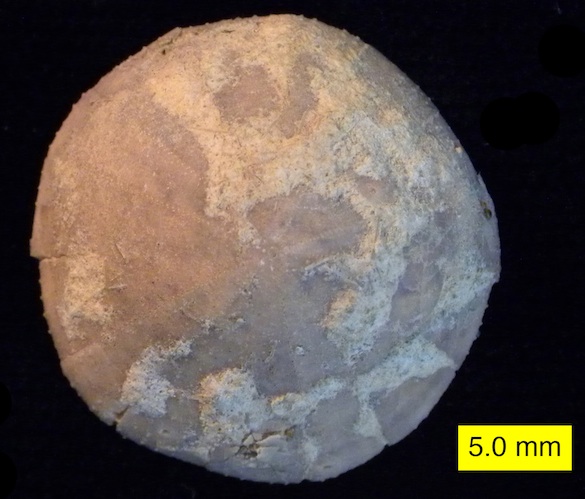 From the view above, this fossil from the Matmor Formation (Middle Jurassic, Callovian) of southern Israel looks like your standard echinoid (a group that contains sea urchins and sand dollars), but turn it on its side (see below) and you see it is unusual. Echinoids have two large categories: those that are globular in shape (like sea urchins) are called “regular“, and those that are flattened (like sand dollars) are “irregular“. (I know, oddly value-laden terms, these.) This specimen belongs to a group that is rounded on its top portion and flattened on its bottom (oral) surface. This between-ness makes it a fun little specimen.
From the view above, this fossil from the Matmor Formation (Middle Jurassic, Callovian) of southern Israel looks like your standard echinoid (a group that contains sea urchins and sand dollars), but turn it on its side (see below) and you see it is unusual. Echinoids have two large categories: those that are globular in shape (like sea urchins) are called “regular“, and those that are flattened (like sand dollars) are “irregular“. (I know, oddly value-laden terms, these.) This specimen belongs to a group that is rounded on its top portion and flattened on its bottom (oral) surface. This between-ness makes it a fun little specimen.
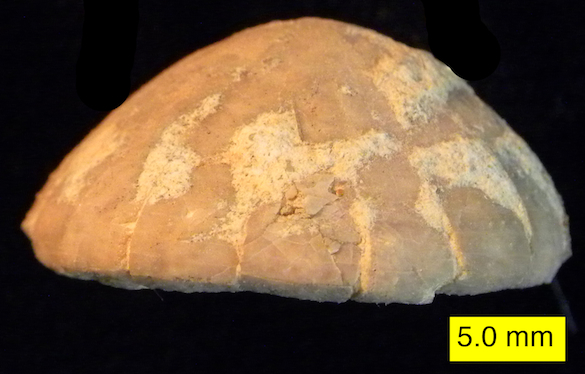 I could not identify this echinoid, which we collected on our Israel expedition this summer, because I could not find the most important diagnostic features. Fortunately my colleague Andrew Smith, recently retired from the Natural History Museum in London, quickly knew what it was. (This is not surprising — he’s the world’s expert on fossil echinoids. Check out his incredible Echinoid Directory.) Andrew identified this specimen as belonging to the genus Holectypus Desor, 1842, and probably the species Holectypus depressus (Leske, 1778).
I could not identify this echinoid, which we collected on our Israel expedition this summer, because I could not find the most important diagnostic features. Fortunately my colleague Andrew Smith, recently retired from the Natural History Museum in London, quickly knew what it was. (This is not surprising — he’s the world’s expert on fossil echinoids. Check out his incredible Echinoid Directory.) Andrew identified this specimen as belonging to the genus Holectypus Desor, 1842, and probably the species Holectypus depressus (Leske, 1778).
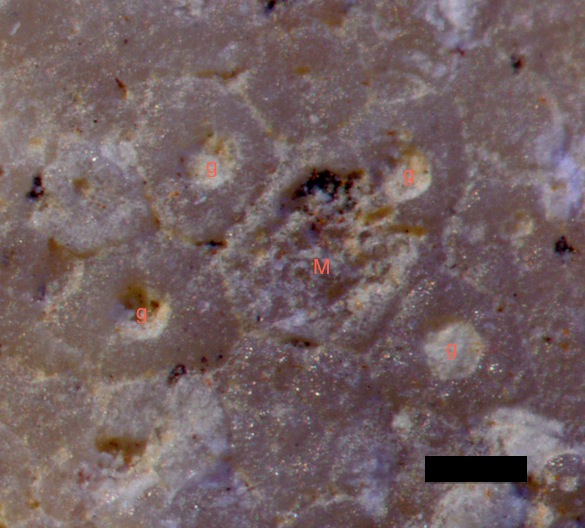 The first feature Andrew noticed was the apical disk on the very top of the test (the term for an echinoid skeleton). In the above image (where the black scale bar = 200 microns) I’ve labelled the four gonopores (where gametes exit, as you might have guessed) and the madreporite (a sieve plate at the opening of the water vascular system). This arrangement is characteristic of the genus.
The first feature Andrew noticed was the apical disk on the very top of the test (the term for an echinoid skeleton). In the above image (where the black scale bar = 200 microns) I’ve labelled the four gonopores (where gametes exit, as you might have guessed) and the madreporite (a sieve plate at the opening of the water vascular system). This arrangement is characteristic of the genus.
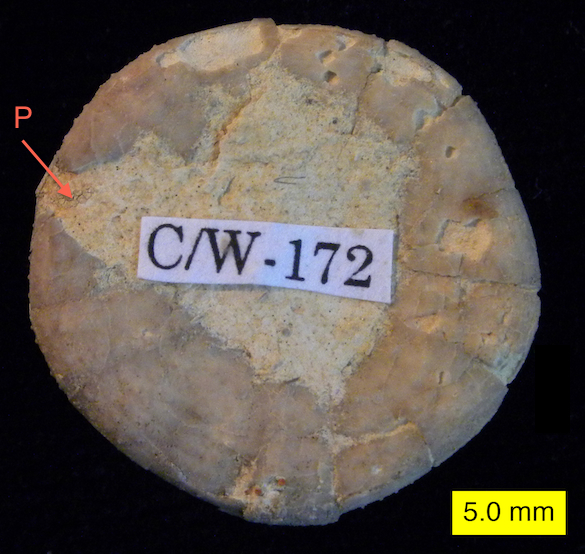 Most surprising to me was Andrew’s identification of the most obvious defining feature of Holectypus, the periproct (the anal opening). I couldn’t find it, but Andrew knew where to look. In this view of the oral surface, it is the gap labeled “P”. Looks just like a place where the test is broken, right?
Most surprising to me was Andrew’s identification of the most obvious defining feature of Holectypus, the periproct (the anal opening). I couldn’t find it, but Andrew knew where to look. In this view of the oral surface, it is the gap labeled “P”. Looks just like a place where the test is broken, right?
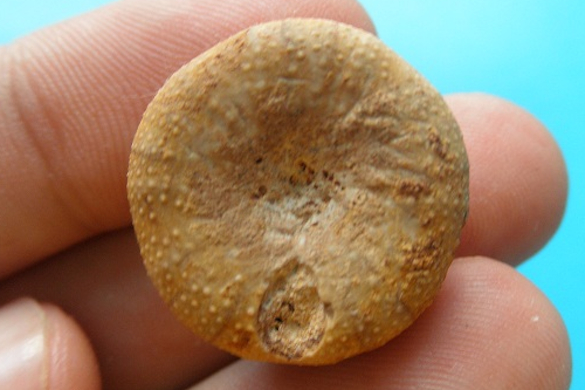 Here is the oral surface of an unbroken Holectypus specimen from the Callovian of France. The large periproct is immediately visible as the whole at the bottom. Now the broken margin of the periproct on our specimen makes sense.
Here is the oral surface of an unbroken Holectypus specimen from the Callovian of France. The large periproct is immediately visible as the whole at the bottom. Now the broken margin of the periproct on our specimen makes sense.
Holectypus belongs to a group of irregular echinoids still around today. They are sometimes characterized as having “conservative” evolution, meaning they have not changed much over long periods. The irregular echinoids appeared earlier in the Jurassic as a modification of their regular ancestors. They became flattened and bilateral, the periproct moved out of the apical disk, their ambulacra (rows of tube feet visible as tiny holes radiating from the apical disk on the top image) pulled up away from the mouth, and their spines were reduced in size and increased in number. These were primarily adaptations for burrowing into the sediment. Holectypus has retained its inflated upper portion, has relatively large spines (some still cling to our specimen), and still is circular in outline. It was a deposit feeder but not specialized for burrowing.
We wouldn’t want to call this a “transitional fossil”, but it is a nice example of the gradient of adaptations present when there is a major outbreak of innovation as during the rise of the irregular echinoids in the Jurassic.
References:
Kroh, A. and Smith, A.B. 2010. The phylogeny and classification of post-Palaeozoic echinoids. Journal of Systematic Palaeontology 8: 147-212.
Rose, E.P.F. and Olver, J.B.S. 1985. Slow evolution in the Holectypidae, a family of primitive irregular echinoids, p. 81-89. In: Keegan, B.F. and O’Connor, B.D.S. (eds.), Proceedings of the Fifth International Echinoderm Conference, Galway, 24-29 September, 1984.
Saucède, T., Mooi, R. and David, B. 2007. Phylogeny and origin of Jurassic irregular echinoids (Echinodermata: Echinoidea). Geological Magazine 144: 333-359.


